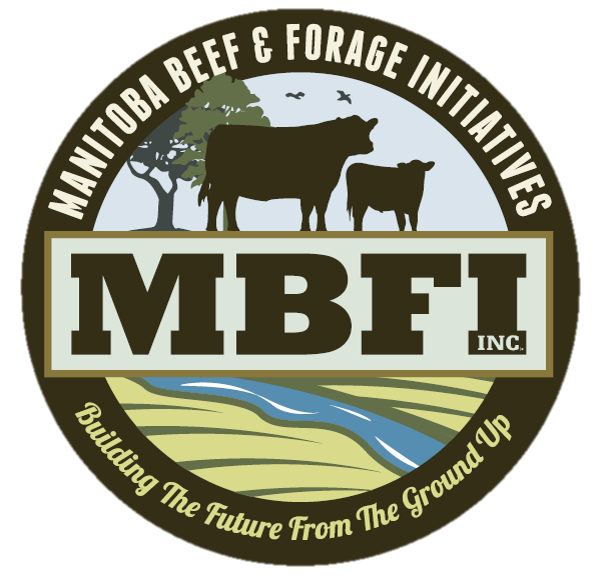Applied research already well underway at MBFI
By Jennifer Paige of The Manitoba Co-operator
Just 18 months into its existence, the Manitoba Beef and Forage Initiative (MBFI) has hit the ground running with a number of research projects.
“Transitioning from the initial concept of MBFI to successfully completing several research projects in such short order is no small feat,” said Ramona Blyth, chair of the MBFI board during the McDonald’s Production Day Tour held at MBFI’s Brookdale research farm on July 26. “It took people with a shared vision, which was demonstrated by all our partners.”
The initiative’s four core partners include Manitoba Agriculture, Manitoba Forage and Grasslands Association, Manitoba Beef Producers and Ducks Unlimited.
These groups have come together to engage in science-based research in order to benefit ecosystems, improve producer adaptability and build social awareness around the beef and forage industries.
Guided by a research advisory committee, MBFI selected nearly a dozen research projects and has started to carry them out at the Brookdale farm this season.
Underway
Current projects at the MBFI Brookdale farm include a study on energy-dense annual forages, which is being led by Juanita Kopp, beef specialist with Manitoba Agriculture.
This project will evaluate the productivity, quality and growth characteristics of energy-dense forages not typically grown in Manitoba, including chicory and plantain.
Rafael Otfinowski from the University of Winnipeg and Kim Wolfe from Manitoba Agriculture are looking at drought and wet meadow grazing, specifically monitoring the effects of early-season grazing on the proliferation of foxtail barley.
Pam Iwanchysko, forage specialist with Manitoba Agriculture has taken the lead on two research projects at the site, the first looking at the impact of annual forage cropping mixtures.
“Basically we are looking at investigating impact of a multi-species mixture of forages on microbiology in the soil,” Iwanchysko said. “We have taken some base measurements before we started and will do some soil monitoring before and after grazing.”
The polycropping project involves 16 acres subdivided into four-acre pastures, seeded with polycrop mixtures. At the beginning of October half of the pastures will be grazed and the other half will be left.
“What we have used is the cool-season grasses, like Italian ryegrass and oats, legumes, as well as peas, vetches and clover and then we used some brassicas as well,” Iwanchysko said. “We have not used any fertilizer as we are going to try and capture some of that fertility through the microbiology and through the nitrogen fixation.”
Soil microbial communities and composition will be monitored throughout the project.
“I think that we have a good collaborative project here. We were able to secure a researcher who will be doing some of the soil monitoring for us. I am really excited to have this project going on here. I think it is a great example of what can be done at anybody’s place,” Iwanchysko said.Research development specialist with Manitoba Agriculture, Kim Wolfe is leading a MBFI project looking at riparian area health and shelterbelts.
photo: Jennifer Paige
Grazing
Iwanchysko will also lead a planned grazing project where researchers will create a planned grazing system with 50 head of cattle and evaluate animal performance and forage productivity.
Shawn Cabak, livestock specialist with Manitoba Agriculture is leading another project that looks at how producers can reduce feeding costs through extended grazing.
“Here at MBFI we have about four months of grazing perennial pastures from June until September. That is generally what a lot of producers do around here. You might get four to five months on your perennial pastures and then when you get into October and it’s dry, you don’t have much regrowth or a lot of grazing in the fall time, so then what do you do, start feeding your stored feed? You can, but it gets expensive,” Cabak said. “The goal is to extend the grazing season by swath grazing barley, oats and millet as well as corn and bale grazing.”
Cabak and his team will assess various extended grazing strategies to see the impacts on cost as well as nutrient returns to the soil.
“Producers who have been practising extensive grazing for a number of years will use a combination of practices. Rarely does one practice get you through the whole winter but by using several methods we plan to graze for the whole year and have nearly zero confinement,” Cabak said.
Waterways
The health and rejuvenation of riparian areas are also being examined.
Research development specialist with Manitoba Agriculture, Kim Wolfe is leading a project on riparian health assessment and shelterbelts, which has begun evaluating site trends, determining the overall condition of riparian areas both with and without grazing impacts, cropping practices and planted buffer strips.
“In a healthy riparian area you want to see a lot of deep-rooted vegetation, diverse group of plants of all different ages,” Wolfe said. “In an unhealthy riparian area you are going to lack that heavy vegetation or it is going to be heavily browsed and there will be non-native shallow-rooted grasses.”
For those concerned about the health of riparian areas on their property Wolfe recommended conducting a riparian health assessment.
“There is a good manual online from Alberta Cows and Fish, and this one is exclusively for lakes, sloughs and wetlands. This can help you to determine the health of your riparian areas,” Wolfe said.
For more information on the manual, visit: http://cowsandfish.org/publications/assessment.html.
Land management specialist, Marla Riekman will also be working with MBFI, taking an in-depth look at how various forage and grazing management practices can influence soil health.
For more information on MBFI projects visit http://www.mbfi.ca/.
